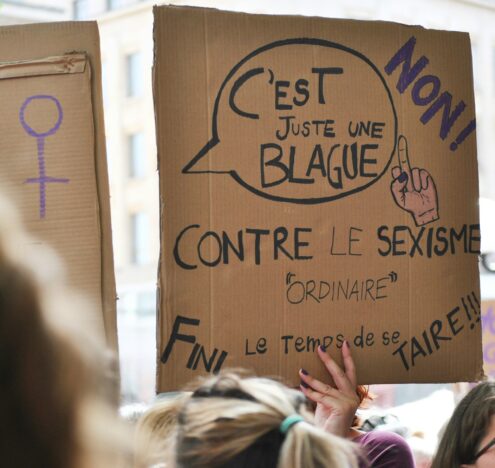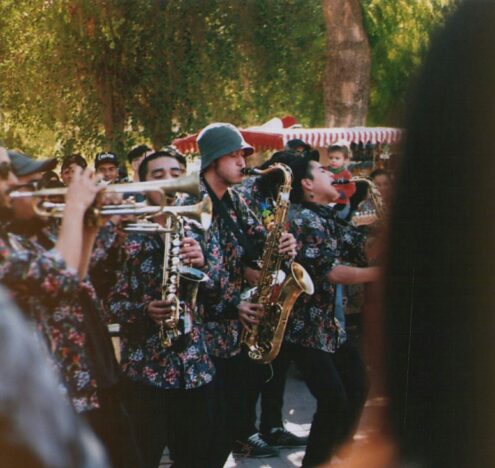This month’s installment of Inkstick’s monthly culture column, The Mixed-up Files of Inkstick Media (inspired by From the Mixed-up Files of Mrs. Basil E. Frankweiler), where we link pop culture to national security and foreign policy, traces some of the effects of the introduction of Stanislavsky’s “method” technique of acting on the development of our modern relationship with national security, multimedia consumption, storytelling, and perceptions of reality.
If I may toot my own horn and quote my own Instagram post from February 2022: “Every time I find myself glued to my phone, I feel the discomforting whispers of Foucault in my ear a la Spongebob Squarepants-style, asking me, ‘Do you feel it? Do you feel it now Mr. Krabs?’ ‘It’ being the panopticon, of course.”
I know I can’t be the first person to point out how Foucault’s concept of the panopticon or Sartre’s notion of Simulacra seem more and more telling of the future we’re slipping into as social media platforms and technological advancements in virtual reality (VR) and augmented reality (AR) become more and more widespread.
If identifying the clear delineation between fact and fiction was so easy, then surely we wouldn’t be facing such vicious misinformation wars on Twitter and Facebook.
As a former thespian though, last year I was struck by a podcast’s exploration of the history of Russian actor and director Konstantin Stanislavski’s technique of method acting and how it came to take shape the way we currently know it in the United States. The cultural tastes for entertainment shifted in the United States around the mid-20th century from preferences for the overtly melodramatic and theatrical to the more subdued and realistic shows of emotional complexity that we see dominate today. And sure, sometimes we can still clearly differentiate between the authentic and the performance, but relative to our pre-hyper-techno age, we more often cannot now. For example, it’s an open secret at this point that reality TV shows like “The Bachelor” do in fact have a script of some form or another. The Kardashians and their public personas are entirely fabricated and curated according to their master publicist Kris Jenner. Tumblr even created entire narratives and seemingly niche cultural pockets rich in history about a 1973 Martin Scorsese film named “Goncharov” that never actually existed (but more on that one later).
And, in pursuit of staying topical and relevant as all influencers must: a quick nod to the Oscar nominations. What proportion of the population likely understands the distinctions between fact and fictitious Hollywood glamorization in such films as six-time Academy Award nominee “Top Gun: Maverick”? Sure, Iran has uranium enrichment facilities, but lack of education on the finer details of nuclear energy vs. weapons development or on the region in question as a whole is also what made convincing the public of the Iraq War relatively easy. Likewise, Clint Eastwood’s 2014 film “American Sniper” also received six Academy Award nominations, where the film being based on a true story sidelined its calculated portrayal of US militarism.
If identifying the clear delineation between fact and fiction was so easy, then surely we wouldn’t be facing such vicious misinformation wars on Twitter and Facebook. I first began thinking about this on more personal terms several months ago in the aftermath of The Amber Heard vs. Johnny Depp defamation trial. Many others since then have also noted the blurring of reality in the Internet’s consumption of the sensation, the symbolic final nail in the coffin of the Me Too movement and the new blueprint for discrediting women or femme victims of violence. That blueprint was quickly taken up by defenders of Tory Lanez in a trial concerning an incident in 2020 during which Lanez shot Megan Thee Stallion in the foot. What supporters of Depp and Lanez seem to ignore is that both men were ultimately found guilty — Depp of his own defamation charge and Lanez of three different charges.
“Save the women and children first,” alleges general societal norms. Yet, there exists the simultaneous and increasing likelihood that no matter the evidence, your trauma may instead be perceived on a mass scale as trivial, a hoax, another performance of “unreality.” Before “save the women and children” prevails the notion that “the winner is the teller of history,” and the winner need not even be the literal winner as in the case of Stallion. But what of the development of acting since Stanislavsky in regard to our relationship with national security today?
The Method In Hollywood
Despite audiences having initial misgivings about the style of performance as it first came to prominence in the mid-20th century, “The Method” or classical acting is an approach to the craft of performance credited to Stanislavsky who rose to prominence in the late 1800s. It’s worth noting that method acting as it is most known in the United States diverged rather significantly from Stanislavsky’s own development of the technique.
Members of Stanislavsky’s theatre troupe taught such disciples as Lee Strasberg and Stella Adler in 1923, who later developed the techniques into sub-styles. For example, Strasberg emphasized emotional memory (a specific technique Stanislavsky abandoned by the time Strasberg founded The Group Theatre in 1931, which Adler also joined), whereas Adler emphasized action and imagination. The method’s focus on realistic, emotionally driven characters contrasts earlier styles of acting and writing that utilized more of a preset of tropes or stock characters like in Italian 16th-century theatre known as commedia dell’arte.
Nowadays, realistic complexity is highly regarded. But the consequences we face in stories built upon hyper-realistic nuance in performance is when audience members or consumers overlook the other layers of nuance required to critically understand the purpose of that character or story and thus obfuscate what is meant to be objectively questionable or straight up deplorable behaviors. Examples include the protagonists of “Bojack Horseman” or “Catcher in the Rye.” In addition, influences from novels such as “Catcher in the Rye” or Stephen King’s “Rage” are sometimes so warped as to become inspiration for real-life violence. One case of a literal bad actor (pun intended) justifying outright abusive behaviors is Jared Leto on the set of “Suicide Squad,” all in the name of “the method.”
“I always say about people who do method acting, you only ever see people do the method when they’re playing a-holes,” Robert Pattinson pointed out in an interview with Variety.
Unreality As Reality
Direct effects in my personal life and most youth my age or younger stem from content on platforms like Instagram or TikTok. And although I’ve outgrown my prime from the 2012-era Tumblr Girl™ (ironic), Tumblr as a platform is far from dead. In fact, its users created such a maelstrom of content — fake posters, fake cast lists, fake music compositions, fake quotes — so un-ignorable over the fabricated Scorsese film, “Goncharov,” that Hollywood’s own elite got in on the action. Linda Carter claims to have attended “Goncharov’s” premiere with Henry Winkler. Ryan Reynolds posted a fake quote from the film with the hashtag “#unreality.” And thus, the status of “Goncharov” in the Hollywood canon was secured, especially after Scorsese’s daughter Francesca shared screenshots of a text exchange with her father where she asks if he’s seen the buzz around the fake film. He simply responds, “Yes. I made that years ago.”
Jokes aside, from what I can see, Gen Z has a unique flavor of “realism” and “escapism” in how they create and consume online content. Take this brief Instagram reel from the account @tahalikesyou deftly portraying key differences in Millennial vs. Gen Z humor and approach to online storytelling. While no generation is immune from the pitfall of oversharing online, the ways in which each generation does so are distinct. For example, Gen Z specifically tends to openly talk about their most traumatic or difficult experiences online but near exclusively in a self-deprecating and “laughing through the pain” kind of way.
Only ever so slightly in their defense, the current pop cultural default to meme-ifying everything can be at least partially attributed to a desensitization to what many see as a crumbling world around them.
This pseudo-vulnerability of Gen Z online is a potent driver for the deepening sense of intimacy in parasocial relationships between users, with celebrities, and even sometimes with corporate accounts like the Duolingo owl (personally, I’m a larger fan of whoever is running the Dunkin Donuts Instagram account). Still, without a meaningful understanding from these young minds of that “para” part in the parasocial relationships they’re building. Thus, there’s a growing sense of connection paired with a growing sense of loneliness that’s been difficult for some to know how to reconcile. I’m not arguing that online relationships cannot be genuine and online gatherings cannot facilitate real growth of sincere support and community, but navigating an ambiguous landscape of when content creators may be acting in good or bad faith is getting harder and harder for audiences of all ages. Reality and performance have become so interwoven it’s an unfair game for us to try teasing apart the threads without any help or guidance.
Beyond Gen Z on TikTok, an extreme case of the consequences when performance and reality become indistinguishably enmeshed is the accusations of children from the Sandy Hook Elementary School shooting being “trauma actors,” where a marginal though very vocal group thought mass death of children was a believable stage play. Likewise, after President Donald Trump’s assassination of Iranian General Qasem Soleimani, Twitter was ablaze with memes about the start of World War III and what tactics they’d use to dodge a military draft.
Only ever so slightly in their defense, the current pop cultural default to meme-ifying everything can be at least partially attributed to a desensitization to what many see as a crumbling world around them. For example: A skit about a public relations manager reacting to Gwen Stefani’s statement saying “My god, I’m Japanese” in defense of her Harajuku Girls era; coining of a new framework “new poor” and “old poor” in response to widespread shock at ballooning food prices; one user’s plea to date shorter men after a New York Times guest essay that engages in a new creative take on eco-fascism; and a specifically Pakistani meme “wow grape” that Pakistani Senator Sehar Kamran is working to redirect into a fundraising opportunity for Pakistani flood relief. And these are just a mere handful of examples from just five minutes of scrolling through my TikTok DMs with friends.
The Internet and the mass spread of social media have given us an unparalleled level of connectedness, the ability to know within minutes or sometimes seconds what’s happening in a place thousands of miles away from our own physical location. Simultaneously fostered is an intrinsic disconnect with what we see flit across our screens: another tragedy!? TikTok users joked in comments about the United States not winning gold in shooting at the Summer Olympics but the first three weeks of 2023 have already seen 39 mass shootings. What’s to happen should a state begin nuclear weapons testing again? Worse yet, if a state uses a nuclear weapon in an active combat zone? Outside of nuclear, if the conflict in Ukraine were to escalate to a conventional but full-scale international war, would the Internet meme its way to peace then as well? Or the ultimate what-if: What if an entity deep-faked a nuclear bomb attack (or some other national security threat) convincingly enough to trigger a genuine full-scale nuclear war?
Manipulating The Deep Learning Models
While many of us maintain at least vague awareness of the latest developments in AI software, so little is understood about the actual structure and mechanisms within the coding. In September 2022, an AI art user was abuzz about “Loab” the AI ghost who kept popping up in several generated images (content warning: some of Loab’s images are extremely grotesque). The Twitter thread ultimately reads like a modern copypasta when in truth, the generator happened to fixate on Loab’s likeness as all subsequent images were seeded with earlier images generated of Loab.
Ultimately, my deepest concern now is a dearth of quality guidance for online audiences about how social media and technology in general are tools that can be used both to harm and to heal, depending on how mindful we are about our relationship with the algorithms backing each of the products. Bearing witness to international instabilities in ways never before so simultaneously intimate and detached, these considerations are certain to have long-term effects on our society’s ability to manage the infrastructure of world order (assuming there ever was any or still is any).
Other examples pointed out by one of my tech-y TikTok favorites, Professor Casey Fiesler, include how the surge in “I forced a bot to watch/read xyz…” posts around 2018 were all fake. Since then, however, OpenAI and their later software, including GPT-3 and ChatGPT, are gaining notoriety as the output from these deep learning models become increasingly human-like (but that discussion is for another column’s installment).
I’m an avid supporter of the idea that everything is political. When I learned that Facebook algorithms prioritize content that makes users mad because it drives up engagement as we “angry react” or rage comment, I stopped sharing or commenting or even stopped reading such inflammatory posts. Perhaps social media algorithms and interfaces are designed to manipulate us, and I won’t pretend like they aren’t still largely successful given my copious screen time spent on their apps. But while scrolling, I still fundamentally try to consume in a way that manipulates the algorithm back. I’m teaching the software that if it wants higher engagement levels from my account, it’s better off showing me enjoyable and enriching content instead of infuriating and degrading.
Consequently, when my younger sister, who primarily watches videos about dogs and carpet cleaning, catches a glimpse of my “For You” page on TikTok, she guffaws in disbelief. “Is that really your TikTok? Just endless 3-minute video deep dives into some socio-political analysis?” To which I respond, “You really sit on TikTok for three hours watching 3-minute videos of someone power washing carpets?”
To each their own. At least we overlap enough to send each other cute pet videos.
“I need to know when you’re on stage and when you’re off stage,” as my prepubescent era dreamboat Robert Pattison succinctly put it in the same Variety interview.





















